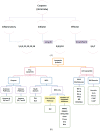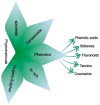Flavonoids in Cancer and Apoptosis
- PMID: 30597838
- PMCID: PMC6357032
- DOI: 10.3390/cancers11010028
Flavonoids in Cancer and Apoptosis
Abstract
Cancer is the second leading cause of death globally. Although, there are many different approaches to cancer treatment, they are often painful due to adverse side effects and are sometimes ineffective due to increasing resistance to classical anti-cancer drugs or radiation therapy. Targeting delayed/inhibited apoptosis is a major approach in cancer treatment and a highly active area of research. Plant derived natural compounds are of major interest due to their high bioavailability, safety, minimal side effects and, most importantly, cost effectiveness. Flavonoids have gained importance as anti-cancer agents and have shown great potential as cytotoxic anti-cancer agents promoting apoptosis in cancer cells. In this review, a summary of flavonoids and their effectiveness in cancer treatment targeting apoptosis has been discussed.
Keywords: anti-cancer therapy; apoptosis; cancer; flavonoids; natural compounds; phytochemicals.
Conflict of interest statement
The authors declare no conflict of interest. The funders had no role in the design of the study; in the collection, analyses, or interpretation of data; in the writing of the manuscript, or in the decision to publish the results.
Figures












References
-
- Prakash O., Kumar A., Kumar P. Anticancer potential of plants and natural products: A review. Am. J. Pharmacol. Sci. 2013;1:104–115. doi: 10.12691/ajps-1-6-1. - DOI
Publication types
Grants and funding
LinkOut - more resources
Full Text Sources

